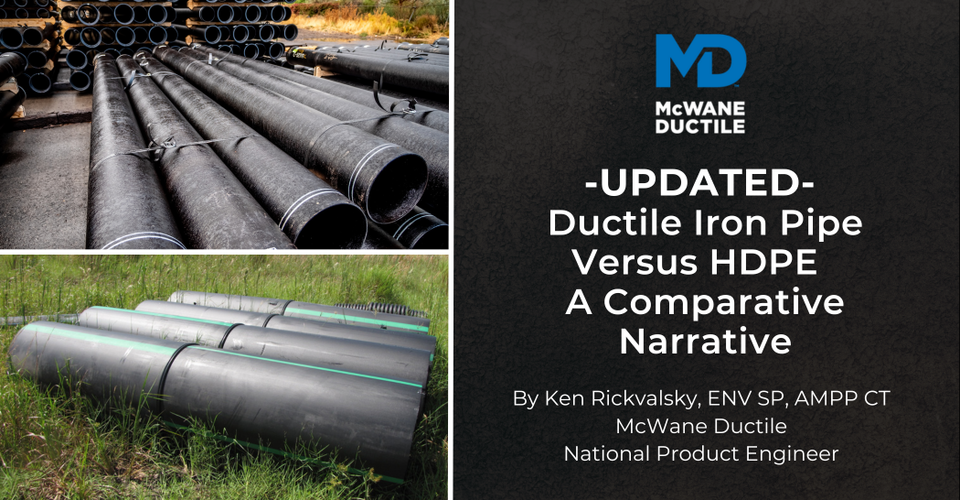When designing or constructing ductile iron pipe utility projects, there is often a discussion of about what joint to use for restraint at the fittings - TR Flex® fittings or the more common Mechanical Joint (MJ) fitting with retainer glands?
As a contractor or engineer, what is important to you? Time, flexibility, or cost? Let me guess, you want all three. Below we will look at some of the items to consider that may assist you in this decision.
Value Engineering
As a contractor or engineer, you should always consider what is the best product for the application. Fittings must be restrained by either the traditional, conservative approach using thrust blocks (old technology) or by employing a self-restraining system at the fitting.
In unstable soils or high-pressure applications, you need to restrain your fittings by one means or another. TR Flex® fittings or Mechanical Joint with restraint glands offer two “stand alone” systems that eliminate the need for thrust blocks, providing value-added engineering capabilities to your project.
To compare the two methods of restraint at the fittings, let’s look at the TR Flex® system first.
Boltless Restraint Saves Time
TR Flex® fittings utilize a push-on (compression) joint configuration, so the installation is performed in the same fashion as a Tyton Joint® push-on pipe. You push it until it is “home.” The Tyton® gasket makes the water tight seal around the pipe OD and then locking segments inserted into the bell slot(s) provide a positive axial lock between the bell and the factory applied weld bead.
TR Flex® is a “boltless” restrained joint. What does that mean to you? It means the bolts necessary to tighten the joint and provide the watertight seal have been eliminated. No more keeping up with bolts and nuts that can get lost or muddy in the trench. Potential for corrosion is thus reduced by eliminating bolts and/or dissimilar metals.
Additionally, TR Flex® does not require any extra tools, such as an impact wrench or a torque wrench, to complete the assembly. You just need to install the applicable number of locking segments, either two, four, or eight depending on pipe diameter, and the rubber retainer for each set.
The locking segments are conveniently marked “red for right” and “black for left.” Installation time for a 36-inch TR Flex® connection is less than five minutes compared to more than one hour to install a 36-inch MJ fitting and retainer gland.
With a mechanical joint (MJ) and retainer gland, there are two distinct processes in the assembly procedure. Each of these processes have several steps requiring significant time to complete:
- Compressing the MJ gasket in the adjoining bell by tightening the tee-head bolts at the proper torque for assembly.
- Engaging the restraining mechanism by tightening the locking wedges to the pipe.
The number of tee-head bolts and wedges requiring tightening can be significant depending on the size of the fitting. For example, on a 36-inch MJ fitting, you will need to tighten 24 tee-head bolts and 24 wedges.
Joint Deflection
When you need just a little extra deflection, for example, at a closure or tie-in to an existing line, TR Flex® fittings will provide just a little extra flexibility. The available deflection in TR Flex® restrained fittings as compared to the average amount of available deflection in MJ fittings with wedge actions restraints is shown in the chart below:
For additional information on restraint glands, visit Tyler-Union Foundry for a look at the TufGrip™.
Fabricated Spool Pieces
Spool pieces manufactured at the exact laying length required are available for connections between TR Flex® fittings. Ordering these specially fabricated pieces helps to reduce cutting pipe in the field. This saves time required to install the material. More importantly, it may reduce the potential for accidents as well.
However, in the event of any unforeseen circumstances or obstructions, such as an existing utility line, TR Flex® Gripper Rings or weld-on field kits are also available as additional options to accommodate field cuts. The illustration below provides an example layout of restraint joints, should the Gripper Ring be used.
Ease of Assembly
We understand that many out there are unfamiliar with assembling TR Flex® fittings and that mechanical joints are certainly more common. Assembly of a pipe spigot into a MJ fitting and drawing the joint together with the follower gland and bolts makes for a seemingly easy installation. Because of history with the product, contractors are accustomed to MJ and we know humans, by nature, are uncomfortable with change.
The MJ joint, on the surface, appears quite easy to “home” compared to TR Flex® fittings. However, TR Flex® fittings are quickly installed using one or two come-a-longs and a little patience.
Installation time is reduced using TR Flex® regardless of any above ground pre-installation that may be done. Anyone that has attempted to maneuver a 36” retainer gland while in a trench when it is 33 degrees, rainy, and cold could greatly appreciate just sliding a few TR Flex® locking segments into place.
Pro tips: There are a couple of notes of caution to consider when using TR Flex® fittings:
- TR Flex® connections are not recommended for vertical applications as gravity may not allow the joint to remain in tension which is important, as previously explained.
- TR Flex® fittings should be ordered direct from the factory and therefore, may not be as readily available as MJ fittings.
Cost Factors
Another factor to consider when selecting the right system for your needs is the cost, especially if the MJ gland requires stainless steel bolts. The price of these bolts alone can easily justify the switch to a boltless system.
If you have included the extra cost of stainless-steel bolts in your bid, you may also encounter delivery problems. The stainless-steel bolts are often a special order and may not be readily available!
Conversely, our Ohio plant location stocks several TR Flex® fittings in common configurations, making it convenient to ship them with your pipe loads direct to the job site.
Bottom Line
The bottom line is that the TR Flex® fittings are typically a better choice than the conventional MJ fittings for several reasons. Every project presents unique requirements and we at McWane Ductile strive to assist our customers with superior products and knowledge. Always remember to Work Hard, Work Smart, and Safe, and together we will continue “Building Iron Strong Utilities for Generations.”
Need Assistance With Your Water Infrastructure Project?McWane Ductile offers multiple services for our customers extending far beyond manufacturing ductile iron pipe. From design to installation, we take great pride in providing education and assistance to water professionals throughout the water industry.
I encourage you to call your local sales representative for a live presentation on all our products or check out our digital offerings:














